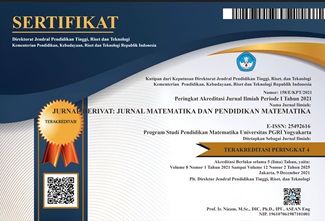Analisis Pembentukan Portofolio Optimal Saham-Saham JII30 Dengan Model Indeks Tunggal Periode New-Normal
DOI:
https://doi.org/10.31316/j.derivat.v9i1.2758Abstract
The purpose of this research is to analyze the formation of the optimal portfolio on the Jakarta Islamic Index 30 (JII30) stocks during the new normal period. The model used is a single index model. This study uses secondary data for the period December 2020 - November 2021 from stocks listed on JII30 on the Indonesia Stock Exchange. The results showed that the selected model provides optimal benefits. The risk-free asset return does not provide a higher return than the simulation results. Of the 30 stocks listed in JII30, obtained 7 stocks with the most significant proportion of funds, namely ERAA (25.72%), MDKA (24.87%), TLKM (17.98%), EXCL (12.82%), AKRA (7.54%), ADRO (6.73 %) and ANTM (4.34%). The formation of the optimal portfolio in this study produces an expected return of 0.009974 or 1%, where the portfolio return is above the market rate of return and the average risk-free rate. Meanwhile, the optimal portfolio risk obtained is 0.003173 and the standard deviation is 0.056327 or 5.63%. The impact of the Covid-19 pandemic which has subsided and the economy is getting better has resulted in the formation of an optimal JII30 portfolio that can be carried out and reduce investment risk during the new normal period.
Â
Keywords: Jakarta Islamic Index 30 (JII30), Single Index model, new normal, Optimal portfolio
References
Al Faruk, A. R., & Marsono, A. D. (2022). Comparative analysis of sharia stock performance before and during covid-19 pandemic in Indonesia. Perbanas Journal of Islamic Economics & Business, 2(1), 65–74. Retrieved from https://joieb.perbanas.id/index.php/Joieb/article/view/44%0Ahttps://joieb.perbanas.id/index.php/Joieb/article/download/44/8
Anam, S. K., Aprianingrum, A., & Moorcy, N. H. (2021). Analisis penentuan portofolio optimal dengan model Markowitz pada Jakarta islamic index (JII) yang terdaftar di bursa efek Indonesia. Jurnal GeoEkonomi, 12(2), 205–220. https://doi.org/doi.org/10.36277/geoekonomi
Ashari, M. S., Geraldina, I., & Simorangkir, P. (2021). Analysis of abnormal returns and financial performance during pandemic COVID-19: Jakarta Islamic Index (JII). Jurnal Al-Qardh, 6(2), 14–28. https://doi.org/10.23971/jaq.v6i2.3258
Bank Indonesia. (2022). Statistik indikator bi-7day. Retrieved February 15, 2022, from https://www.bi.go.id/id/statistik/indikator/bi-7day-rr.aspx.
Bodie, Z., Kane, A., & Marcus, A. J. (2011). Investments. New York: McGraw-Hill/Irwin.
Bursa Efek Indonesia. (2022). Indeks Saham Syariah. Retrieved February 15, 2022, from https://www.idx.co.id/idx-syariah/indeks-saham-syariah/
Chasanah, S I U, Lesmana, D. C., & Purnaba, I. G. P. (2017). Comparison of The Markowitz and single index model based on M-V criterion in optimal portfolio formation. International Journal of Engineering and Management Research (IJEMR), 7(4), 323–328.
Chasanah, S I U, Abdullah, S., Valentika, N., Kiftiyani, U., & Nuha, A. R. (2020). Analisis pembentukan portofolio optimal saham-saham Jakarta islamic index (JII) pada masa pandemi Covid-19. Jurnal Saintika Unpam: Jurnal Sains Dan Matematika Unpam, 3(1), 52–67. https://doi.org/10.32493/jsmu.v3i1.5649
Elton, E. J., Gruber, M. J., Brown, S. J., & Goetzmann, W. N. (2014). Modern Portfolio Theory and Investment Analysis. New York: Wiley.
Ginting, A. B., & Siregar, A. I. F. (2021). Analisis penilaian kinerja portofolio saham syariah dengan metode Sharpe index. Al-Iqtishod: Jurnal Ekonomi Syariah, 3(2), 116–131. https://doi.org/10.51339/iqtis.v3i2.380
Hartono, J. (2014). Teori dan Praktik Portofolio dengan Excel. Jakarta: Salemba Empat.
Hartono, J. (2017). Teori Portofolio dan Analisis Investasi. Yogyakarta: BPFE.
Husnan, S. (2015). Dasar-Dasar Teori Portfolio & Analisis Sekuritas. Ed-5. Yogyakarta: STIM YKPN.
Jin, M., Li, Z., & Yuan, S. (2022). Research and analysis on Markowitz model and index model of portfolio selection. In Proceedings of the 2021 3rd International Conference on Economic Management and Cultural Industry (ICEMCI 2021) (Vol. 203, pp. 1142–1150). https://doi.org/10.2991/assehr.k.211209.186
Kurniasih, A., & Johannes, L. D. Y. (2015). Analisis variabel makroekonomi terhadap kinerja reksadana campuran. Jurnal Manajemen, 19(1), 136–151. https://doi.org/10.24912/jm.v19i1.110
Najamuddin, Y., Meidawati, N., Putri, N. S., Nustini, Y., & Kholid, M. N. (2021). Optimal portfolio analysis of manufacturing entities in the Indonesia Sharia Stock Index. International Journal of Research in Business and Social Science, 10(8), 189–199.
Nalini, R. (2021). Optimal portofolio construction using Sharpe’s single index model-a study of selected stocks from BSE. International Journal of Advanced Research in Management and Social Sciences, 3(12), 72–93. https://doi.org/10.2139/ssrn.3852369
Pratama, L. A. (2019). Analisis pembentukan portofolio saham optimal menggunakan metode single index model (Studi empiris pada saham indeks LQ 45 di bursa efek Indonesia). Jurnal Ilmu Manajemen, 16(1), 48–60.
Sharpe, W. F. (1963). A simplified model for portfolio analysis. Management Science, 9(2), 277–293.
Silalahi, I. V, Ningrum, H. F., & Helia, S. (2021). Single index model dalam membentuk portofolio optimal pada saham perusahaan Jakarta islamic index. Jurnal Administrasi Kantor, 9(2), 273–286.
Tandelilin, E. (2017). Pasar Modal Manajemen Portofolio & Investasi. Yogyakarta: Kanisius.
Yahoo Finance. (2022). Harga Saham Indonesia. Retrieved February 15, 2022, from https://finance.yahoo.com/
Downloads
Published
Issue
Section
Citation Check
License
Authors who publish with this journal agree to the following terms:
-
Authors retain copyright and grant the journal right of first publication with the work simultaneously licensed under a Creative Commons Attribution-ShareAlike 4.0 International License that allows others to share the work with an acknowledgment of the work's authorship and initial publication in this journal.
- Authors are able to enter into separate, additional contractual arrangements for the non-exclusive distribution of the journal's published version of the work (e.g., post it to an institutional repository or publish it in a book), with an acknowledgment of its initial publication in this journal.
- Authors are permitted and encouraged to post their work online (e.g., in institutional repositories or on their website) prior to and during the submission process, as it can lead to productive exchanges, as well as earlier and greater citation of published work (See The Effect of Open Access).







